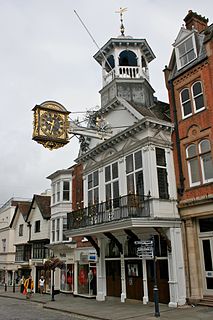
Oswestry is a market town, civil parish and historic railway town in Shropshire, England, close to the Welsh border. It is at the junction of the A5, A483 and A495 roads.

Shrewsbury and Atcham was, between 1974 and 2009, a local government district with borough status in Shropshire, England.

The Guildford Guildhall is a Guildhall located on the High Street of the town of Guildford, Surrey. It is a Grade I listed building.

The Much Wenlock Guildhall is a guildhall located on Wilmore Street in Much Wenlock, Shropshire. It is a Grade II* listed building.

Cowbridge Town Hall is a public building in the High Street of Cowbridge in South Wales. The town hall, which is the meeting place for Cowbridge with Llanblethian Town Council, and also houses the town clerk's office, the committee rooms and the Cowbridge Museum, is a Grade II* listed building.

The Old Shirehall was a municipal facility in Market Square, Shrewsbury, Shropshire. It was demolished in 1971 to make way for a retail and commercial centre.

Poole Civic Centre is an Art Deco municipal building in Poole, Dorset. Since 7 October 2019 the building has been a Grade II listed building. Also sometimes known as Poole Town Hall, the civic centre was the headquarters of Poole Borough Council until 2019.

Dudley Council House is a municipal building in Priory Road, Dudley, West Midlands, England. The Council House, which is the meeting place of Dudley Metropolitan Borough Council is a Grade II listed building.

Folkestone Town Hall, also known as The Guildhall, is a municipal building in Guildhall Street, Folkestone, Kent, England. The town hall, which was the headquarters of Folkestone Borough Council, is a Grade II listed building.

Thetford Guildhall is a municipal structure in the Market Place in Thetford, Norfolk, England. The town hall, which was the headquarters of Thetford Borough Council, is a Grade II listed building.

The Municipal Buildings are based on the north side of High East Street in Dorchester, Dorset, England. The structure, which was the headquarters of Dorchester Borough Council, is a Grade II* listed building.

Faversham Guildhall is a municipal building in the Market Place in Faversham, Kent, England. The structure, which was the meeting place of Faversham Borough Council, is a Grade II* listed building.

Tiverton Town Hall is a municipal building in St Andrew Street in Tiverton, Devon, England. The structure, which was the meeting place of Tiverton Borough Council, is a Grade II listed building.

Devizes Town Hall is a municipal building in St John's Street in Devizes, Wiltshire, England. The structure, which is the meeting place of Devizes Town Council, is a Grade II* listed building.

Saltash Guildhall is a municipal building in Fore Street, Saltash, Cornwall, England. The structure, which was the meeting place of Saltash Borough Council, is a Grade II listed building.

Montgomery Town Hall is a municipal structure in Broad Street, Montgomery, Wales. The town hall, which served as the meeting place of Montgomery Borough Council, is a Grade II* listed building.

Ballyclare Town Hall is a municipal structure in The Square, Ballyclare, County Antrim, Northern Ireland. The structure, which is primarily used as an events venue, is a Grade B2 listed building.

Chipping Norton Town Hall is a municipal building in the Market Place, Chipping Norton, Oxfordshire, England. The building, which is used as an events venue, is a Grade II* listed building.

Bishop's Castle Town Hall is a municipal building in the High Street in Bishop's Castle, Shropshire, England. The building, which is the meeting place of Bishop's Castle Town Council, is a Grade II* listed building.

Clun Town Hall is a municipal building in The Square in Clun, Shropshire, England. The building, which is now used as a museum, is a Grade II* listed building.





















